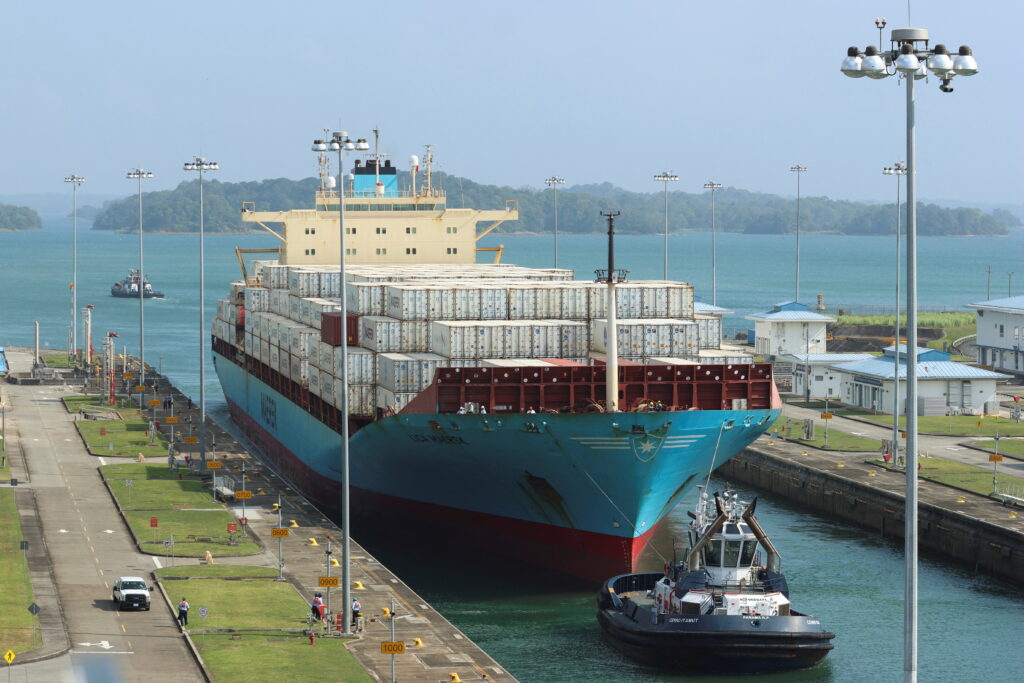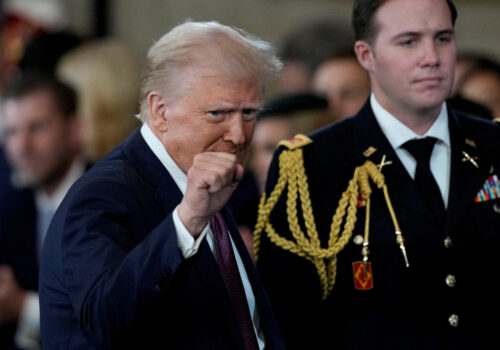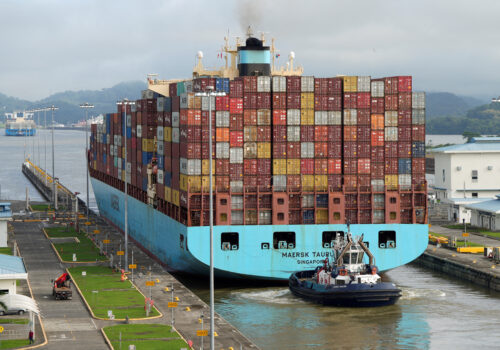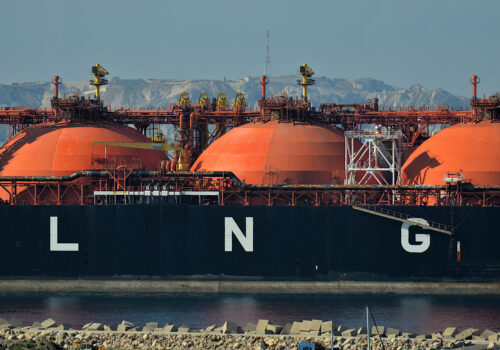It was clear sailing, “without a hitch, accident, or unpropitious incident of any kind.” On August 15, 1914, the cargo ship SS Ancon made the first official transit of the Panama Canal, completing the passage from the Atlantic Ocean to the Pacific Ocean. US diplomat John Barrett was there to record the historic moment, and he marveled at how the pathbreaking voyage already seemed routine. “So quietly did she pursue her way that . . . a strange observer coming suddenly upon the scene would have thought that the canal had always been in operation.”
After the Ancon, the voyage did become routine. By the mid-1920s, annual traffic on the canal surpassed five thousand ships. Today, more than twelve thousand ships per year make the voyage across the isthmus. The quicker, cheaper, and safer way to bridge the oceans has transformed global trade and the Western Hemisphere.
Today, however, an observer coming upon the scene might sense dark clouds on the horizon. In his inaugural address, US President Donald Trump said that the canal had “foolishly been given to the country of Panama.” Panama is treating the United States unfairly and China is operating the canal, he argued, without providing specifics. “We’re taking it back,” he declared. The bridge, it seems, has become an impasse.
Difficult waters require steady guides. Below, Atlantic Council experts deftly steer us through how the canal came about, why it matters today, and what to expect next.
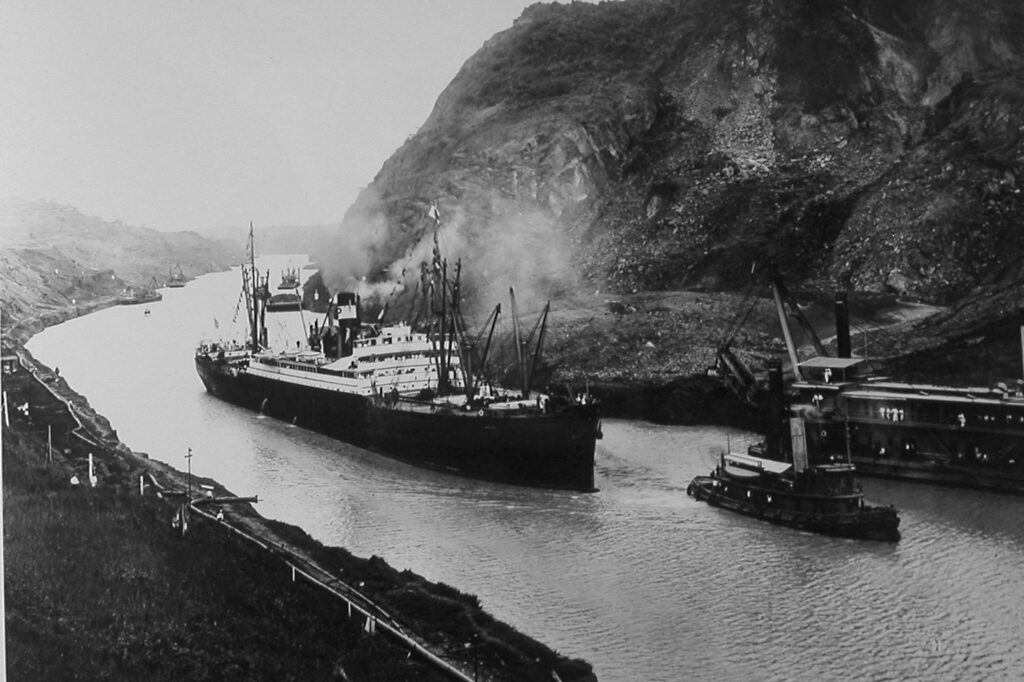
The Panama Canal was the largest US engineering project to date when the SS Ancon (pictured) officially opened the waterway. Direct costs between 1904 and 1914 exceeded $352 million (more than eleven billion dollars today, adjusted for inflation). Records show that 5,609 people died from accidents and disease while working on the canal over this same period, though the true figure is likely higher.
1. What was the US role in building the canal?
US President Theodore Roosevelt’s use of “gunboat diplomacy”—with US warships deployed along Panama’s Pacific and Atlantic coasts—was instrumental in Panama securing its independence from Colombia. In exchange for US assistance, Washington secured its main objective for helping the Panamanian cause: rights to build the canal. In 1903, the Hay-Bunau-Varilla Treaty gave the United States control of a fifty-mile by ten-mile stretch of Panama that divided the country in half and came to be known as the Canal Zone. Ten years later, US President Woodrow Wilson opened the canal, which was constructed with locks designed by the US Army Corps of Engineers and with workers largely imported from Caribbean islands.
—Jason Marczak is vice president and senior director at the Atlantic Council’s Adrienne Arsht Latin America Center.
2. When and how did Panama take ownership of the canal?
Throughout the twentieth century, the United States—with increasing Panamanian animosity—controlled the Canal Zone. Increased tensions, perpetuated by the stark difference between US-controlled Canal Zone life and that outside the zone, led to demonstrations in 1964 that turned violent and resulted in the deaths of both Panamanians and US Marines. This incident sparked new interest across administrations to resolve tensions around the canal, which came to the fore during the presidency of Jimmy Carter, who entered office seeking a new beginning with Latin America.
In 1977, Carter came to an agreement with Panama on a transition for the canal: joint administration until 1999, at which point Panama would fully take over the canal. Among other things, the Permanent Neutrality Treaty requires (a) efficient canal operation; (b) transit fees that are “just, reasonable, equitable, and consistent with international law,” and (c) neutrality of the canal. The Panama Canal Authority, an autonomous entity, was set up to administer, operate, modernize, and set fees for the canal. Since taking over canal operations, Panama has invested more than five billion dollars to expand the canal in order to accommodate larger ships.
—Jason Marczak
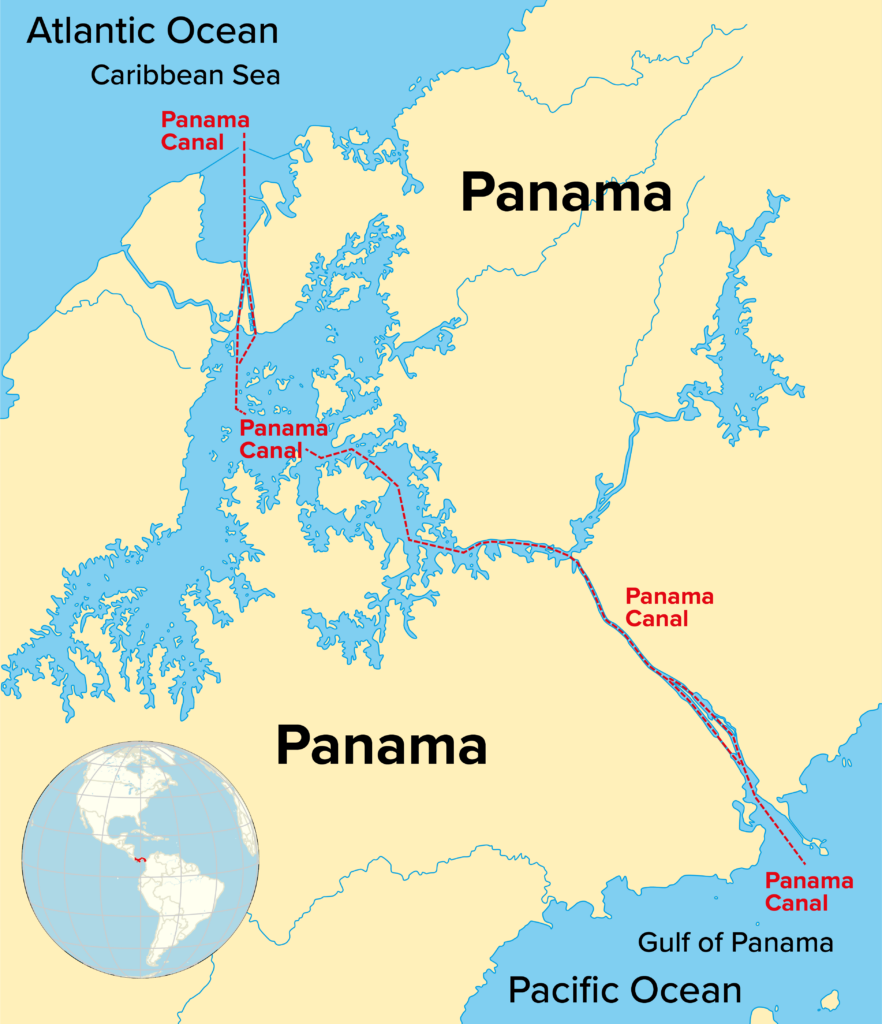
3. What is the canal’s role in international trade today?
The Panama Canal is among the most significant waterways for global trade, servicing 5 percent of the total volume of maritime trade globally. For the United States, the canal is critical for efficient trade. Forty percent of US container traffic passes through the canal annually, carrying about $270 billion in cargo. The Panama Canal is, during standard operating times, the fastest route for trade between the US East Coast and Asia, for example from New York to Shanghai. Trade from Europe to the US West Coast, or South and Central America to Asia (i.e. Brazil to China) also relies on the canal. Still, over 74 percent of the trade volume that flows through the Panama Canal is headed for, or coming from, the United States.
When El Niño exacerbated drought conditions in 2023-2024, causing low water levels in the canal’s largest reservoir, Gatun Lake, the disruption proved the economic value of the canal’s smooth operation. Lower water levels decrease not only the number of vessels able to transit, but also the volume of cargo they can carry.
Canal shipping is not immune to the laws of supply and demand; the fewer vessels able to transit the canal, the higher the price. Furthermore, the Panama Canal Authorities levy a “freshwater surcharge,” which increases when water levels are low, to incentivize water conservation and decrease traffic. The more ships that don’t divert or make reservations during drought, the greater the wait time, which reached a peak of twenty-one days in the summer of 2023. Increased costs and shipping times during the recent drought likewise increased the shipping costs as much as 14 percent year-over-year for dry bulk goods (such as grains and coal), 12 percent for vehicle carriers, and 5 percent and 3 percent for liquefied petroleum gas and liquefied natural gas, respectively.
—Sophia Busch is an assistant director with the GeoEconomics Center.
Container cargo dominates eastward trade while oil goes west
4. What is the canal’s role in energy markets?
The Panama Canal plays a significant role in facilitating energy trade between the Americas and Asia. Shipments of US and Brazilian (as well as Canadian barrels re-exported from the United States) cargoes of crude oil, refined products, and liquefied natural gas (LNG) destined for Asia often transit the Panama Canal. The canal is particularly crucial for LNG, since virtually all operating US LNG capacity is on the US East and Gulf coasts. Finally, liquefied petroleum gas (LPG), an unheralded but vital input for petrochemicals, heating fuel, and engine fuel, is highly dependent on the Panama Canal. The US Gulf Coast accounts for about 40 percent of all seaborne LPG shipments; most of those volumes are directed to Asia.
However, increasing strains on the canal’s capacity to handle transit have, over time, reduced its use as a transit point for energy in favor of other routes. Average Asian volumes of imported crude, clean products, fuel oils, and LNG decreased by 6 percent in 2024 as compared with the average volume between 2021 and 2023.
Though Asia has historically sourced these energy cargoes from a number of sources, particularly the Middle East and the Indo-Pacific, decreasing reliability of the canal has significant consequences for the United States’ ambitions to use energy as a fulcrum of foreign policy partnerships in the region. For example, average monthly volumes of LNG bound for China, Japan, South Korea, and Taiwan from the United States via the Panama Canal decreased by 82 percent compared to the average transit between 2021 and 2023, whereas average monthly volumes transited via South Africa’s Cape of Good Hope increased by 472 percent. As a consequence, US cargoes to Asia are more costly and have a higher emissions footprint.
In the absence of a plan to address either the canal’s capacity issues or clear-cut alternatives for westbound cargoes, the Trump administration’s ability to use energy trade as a tool in its foreign policy with Asia will continue to be limited. The challenge could even deepen as drought and water availability further constrain passage. With this in mind, it’s clear why the canal’s limitations have been elevated from a persistent theme in energy markets to a headline issue for the White House.
—Reed Blakemore is director of research and programs at the Atlantic Council Global Energy Center.
Trump’s warning on the Panama Canal
“We have been treated very badly from this foolish gift that should have never been made, and Panama’s promise to us has been broken.”
—US President Donald Trump,
January 20, 2025
5. What is Trump’s history with the Panama Canal?
Trump’s concerns about the Panama Canal Treaties didn’t materialize in just the last few weeks. In 2003, when the then Trump-owned Miss Universe contest was held in Panama City, he first got to know the country. Even at that time, Trump expressed the view that the United States got ripped off by the treaties. Interactions with Panama came to a head in 2018 when a legal dispute arose between the Trump Organization and a Miami-based hotel investor who was trying to break off ties with the Trump business. The situation escalated into a standoff with Panamanian authorities. Eventually, Trump’s name was taken off the hotel in Panama City at the center of the dispute.
—Jason Marczak
Read more
6. Trump says that US ships using the canal are being overcharged and not treated fairly in violation of the treaty that the United States and Panama have regarding the canal. Is that the case?
Trump’s claims that US ships using the canal are being overcharged and unfairly treated in violation of the Torrijos-Carter Treaty are not supported by evidence. The Panama Canal Authority (PCA), which manages the canal, charges fees based on the size and type of the ships that are using the waterway. Recently, natural factors like decreased water levels have started to affect the canal’s ability to support ships. As a result, in a normal supply and demand way, the pricing structure of the canal has also shifted. The rates are uniform, impartial, and nondiscriminatory, and they apply to all ships regardless of their nationality. What affects the pricing are factors like ship dimensions and design, the type of cargo it carries, and additional loading or unloading that would take place at the ports. The PCA offers a public maritime services calculator, accessible to anyone.
As a side note, the Torrijos-Carter Treaty did include specific and explicit provisions granting preferential treatment to vessels from northern and southern neighbors Costa Rica and Colombia, respectively. But the provisions apply primarily to warships and auxiliary vessels, which are entitled to the same favorable treatment as Panamanian vessels when transiting the canal. This provision, however, is mostly symbolic, and in no way impacts commercial shipping.
—María Fernanda Bozmoski is director of impact and operations and lead for Central America at the Atlantic Council’s Adrienne Arsht Latin America Center.
7. Trump says that China has too much influence over the Panama Canal. What exactly is China’s involvement with the canal, how did it come about, and should the United States be concerned about it?
Latin America is seeking options for infrastructure investment—including port infrastructure—and Chinese companies are leaning into those opportunities across the region, just as they are everywhere else. Beijing is not “operating” the Panama Canal, as Trump claimed. There are five ports adjacent to the Canal. Hong Kong-listed Hutchinson Whampoa operates two of them, one on the Caribbean side and another on the Pacific side. US, Singaporean, and Taiwanese companies operate the other three.
Hutchinson Whampoa has operated its two ports since 1997 (when the US was still jointly managing the canal); China Harbor Engineering Company launched the cruise terminal in 2024. China Harbor is also building a new bridge over the Canal. That project is still underway.
There are multiple concerns when Chinese companies acquire strategic port assets. Beijing could conceivably use Chinese-held ports to position military assets, both overt and covert, near strategic targets in a future military crisis. Since entities affiliated with China operate ports on both ends of the canal, they could potentially slow or even block US and other Western commercial traffic as a coercion tactic. There is also an information-gathering risk, as PRC port companies can track the goods flowing through them and pass that information on to Beijing. That is primarily a concern with ports handling US goods and traffic, as that provides more access to and information on US activities. That concern extends to the equipment non-Chinese-owned ports use to move and scan commercial freight. For example, if a non-Chinese port authority uses PRC equipment to transport or scan shipping freight, that could provide an avenue for Beijing to monitor those activities, even if a Chinese company does not own the port itself.
China’s growing infrastructure footprint is a global challenge. It is not specific to Panama. For example, Chinese companies recently acquired strategic port assets in Peru and Germany. According to recent analysis from the Council on Foreign Relations, Chinese companies have some degree of ownership in at least 129 ports around the world.
For decades, the United States did not offer partner nations an alternative to Chinese investment. When US companies bid for ports and other infrastructure projects, they often bid alone. In contrast, Chinese companies enjoy strong support from China’s state-owned banks; they can offer low prices and attractive loan terms that US companies cannot match. The United States has woken up to this challenge and the need to put Western alternatives on the table. Under the Biden administration, the United States had some big wins outbidding Chinese firms—including Chinese state-owned enterprises—on infrastructure projects.
The United State can prevail over China in this sector. In November 2023, when state-owned China COSCO Shipping Cooperation Limited was seeking to acquire the rights to develop the Elefsina shipyard in Greece, the US International Development Finance Corporation (DFC) stepped in and provided the financing that enabled a Greek company to win the bid, keeping the shipyard in Western hands. If the Trump administration is serious about tackling the challenges associated with Beijing’s growing infrastructure footprint, the way to do so is to put real alternatives forward, and to aggressively advocate for them.
—Melanie Hart is the senior director of the Atlantic Council’s Global China Hub.
After nine years of construction costing more than five billion dollars, the newly expanded Panama Canal opened in June 2016. The first vessel to pass through was the Chinese container ship Cosco Shipping Panama (REUTERS/Carlos Jasso).
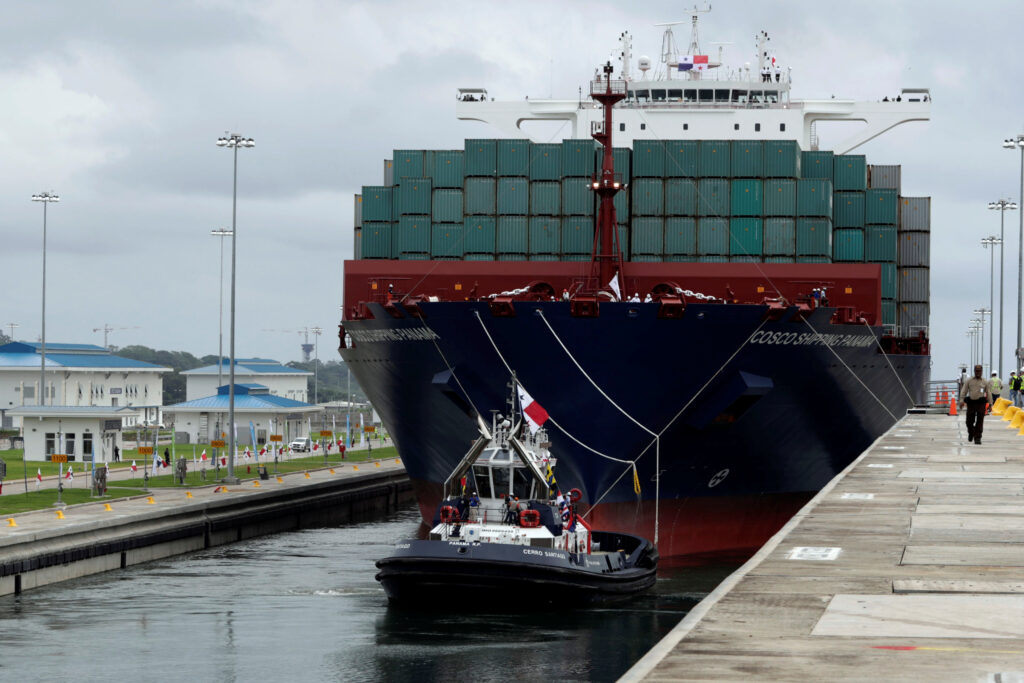
8. How does Panama view Trump’s concerns over the canal?
Panamanian President José Raúl Mulino has responded to Trump’s message that he wants to take back the canal with a clear message that the canal “is and will continue to be Panamanian.” The statement followed a similar message Mulino delivered in a December 22 communiqué. Following the inaugural address, Panama took the issue to the United Nations (UN)—where it currently holds a rotating seat on the Security Council—to express its concern that the United States is threatening the use of force, contrary to the UN Charter.
What is important to reinforce is that the Mulino government is actually quite aligned geostrategically with the United States and with the Trump administration on global issues, including in supporting Israel and seeking to curb the northward flow of migrants. Panama also wants greater US investment to diversify further from the growing—and concerning—influx of Chinese cash. But Mulino has to balance that with domestic political pressures and be a vocal and staunch defender of the canal—even though Trump’s message is likely meant as a negotiating tactic to gain more favorable terms and investment opportunities for US companies, and especially to mitigate concerns around Chinese-controlled ports.
—Jason Marczak
9. How does China view Trump’s concerns over the canal?
Thus far, Beijing views Trump’s statements with glee. Panama views the United States as its preferred partner; where the United States is willing to put forward alternatives, those alternatives are likely to prevail. Beijing, in contrast, is facing growing pushback over the strings it attaches to economic development. Beijing is utilizing Trump’s call to “take back” the Canal as an opportunity to present China as the partner that will recognize and respect Panama’s sovereignty. For example, China’s foreign ministry statements stressed on December 27 that “China will, as always, respect Panama’s sovereignty,” and on January 22 that “We agree with Panama’s President José Raúl Mulino that Panama’s sovereignty and independence are not negotiable . . . we respect Panama’s sovereignty over the canal.”
The current approach gives Beijing the opportunity to position itself as a preferred partner in the region. That is ironic given that Beijing frequently violates other nations’ sovereignty, deploying economic coercion and other forms of bullying to force partner countries to abide by Beijing’s political edicts. If the United States really wants to increase its influence in the region, the best way to do so is to present a valid alternative to China—one that nations will race to join. The Biden administration did so successfully in the semiconductor sector. If the Trump administration can do the same in strategic ports, that will be a massive win. Given the recent Chinese port opening in Peru, Latin America is a great place to start.
—Melanie Hart
Read more
10. What do you expect the United States to do next regarding Trump’s concerns? What should the United States do next?
US Secretary of State Marco Rubio will break tradition this week by making his first international trip as secretary a visit to Central America. This is a welcome change. It’s a signal that the region will be top of the agenda in this administration, as Rubio will travel to Panama along with other Central American countries and the Dominican Republic.
Such a quick and high-level diplomatic trip to Panama is an important next step to move beyond the exchange of words between the two countries’ presidents. The secretary of state may lay out more explicitly for his Panamanian counterparts the specific details of Trump’s grievances and hopefully begin to find a joint pathway forward to address them in alignment with US interests and Panama’s control of the canal. That could mean a discussion on transit fees and auction rates as well as exploring new opportunities for US investment in direct and indirect canal-supporting operations. The United States could then deploy tools of the federal bureaucracy, such as US International Development Finance Corporation funding, to support and incentivize US companies to invest further in the canal and rebuild a greater US presence and corollary stake in the canal’s future.
—Jason Marczak
Further reading
Thu, Jan 23, 2025
Trump’s clear path to securing US oil and gas dominance
New Atlanticist By Richard L. Morningstar, Landon Derentz
The United States should seize on this moment to ensure long-term US LNG exports to Europe permanently replace Russian natural gas flows.
Mon, Jan 20, 2025
What to know about Trump’s day-one promise to take back the Panama Canal
New Atlanticist By Jason Marczak
Trump's presidency can be an opportunity to further use the tools of the US government to advance the US business presence in Panama.
Thu, Jan 9, 2025
The US is right to be concerned about China’s influence over the Panama Canal
New Atlanticist By Gregg Curley
Legitimate concerns about growing Chinese influence over the canal demand Washington’s attention and warrant a measured, diplomatic approach.
Image: Hong Kong LICA MAERSK container ship transits through Agua Clara Locks at the Panama Canal, on the outskirts of Panama City, Panama, April 11, 2024. REUTERS/Aris Martinez
